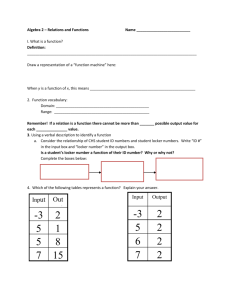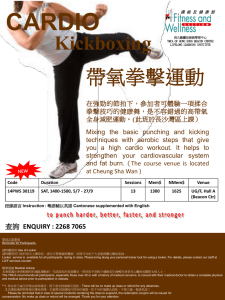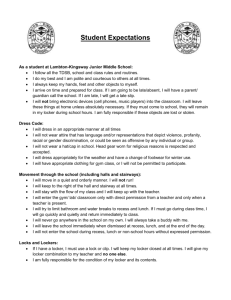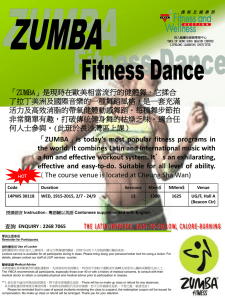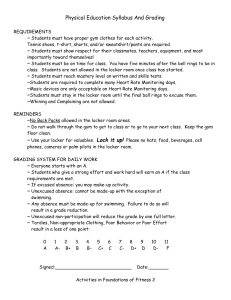PSATMultipleChoice
advertisement
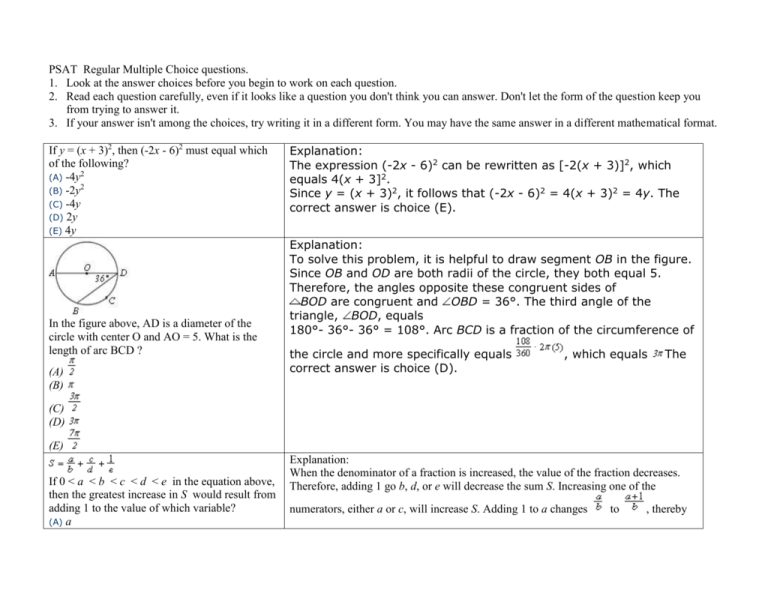
PSAT Regular Multiple Choice questions. 1. Look at the answer choices before you begin to work on each question. 2. Read each question carefully, even if it looks like a question you don't think you can answer. Don't let the form of the question keep you from trying to answer it. 3. If your answer isn't among the choices, try writing it in a different form. You may have the same answer in a different mathematical format. If y = (x + 3)2, then (-2x - 6)2 must equal which of the following? 2 (A) -4y 2 (B) -2y (C) -4y (D) 2y (E) 4y In the figure above, AD is a diameter of the circle with center O and AO = 5. What is the length of arc BCD ? (A) (B) Explanation: The expression (-2x - 6)2 can be rewritten as [-2(x + 3)]2, which equals 4(x + 3]2. Since y = (x + 3)2, it follows that (-2x - 6)2 = 4(x + 3)2 = 4y. The correct answer is choice (E). Explanation: To solve this problem, it is helpful to draw segment OB in the figure. Since OB and OD are both radii of the circle, they both equal 5. Therefore, the angles opposite these congruent sides of BOD are congruent and OBD = 36°. The third angle of the triangle, BOD, equals 180°- 36°- 36° = 108°. Arc BCD is a fraction of the circumference of the circle and more specifically equals correct answer is choice (D). , which equals The (C) (D) (E) If 0 < a < b < c < d < e in the equation above, then the greatest increase in S would result from adding 1 to the value of which variable? (A) a Explanation: When the denominator of a fraction is increased, the value of the fraction decreases. Therefore, adding 1 go b, d, or e will decrease the sum S. Increasing one of the numerators, either a or c, will increase S. Adding 1 to a changes to , thereby (B) b c (D) d (E) e increasing S by (C) . Adding 1 to c changes to , thereby increasing S by . Since b<d, then . Therefore, adding 1 to a will result in the greatest increase in S. The correct answer is (A). If is defined for all positive numbers a and b by Explanation: a b= , then 10 2 = Substituting 10 for a and 2 for b in the expression The correct answer is (A). yields (A) (B) (C) 5 (D) (E) 20 If m and p are positive integers and (m + p) x m is even, which of the following must be true? (A) If m is odd, then p is odd (B) If m is odd, then p is even. (C) If m is even, then p is even. (D) If m is even, then p is odd. (E) m must be even. If xy = 2 and xy 2 = 8, what is the value of x ? (A) (B) 2 (C) 4 (D) 8 (E) 16 Explanation: If m is even, then the expression (m + p) x m will always be even and it cannot be determined whether p is even or odd. This eliminates choices (C) and (D). If m is odd, then (m + p) x m will be even only when m + p is even and m + p will be even only when p is odd. The correct answer is (A) since the truth of statement (A) also eliminates choices (B) and (E). Explanation: Substituting xy = 2 into the equation xy2 = 8, you will obtain (xy)y = 2y = 8, thus y = 4. To find x, substitute y = 4 into one of the two original equations to obtain x = . The answer to this problem is (A). Explanation: Since the sum of the integers in each row, column, and diagonal is the same, it follows that w - 2 + a = 3 + a - 3. Thus w - 2 = 0 so that w = 2. The answer to this problem is (C). In the incomplete table above, the sum of the three integers in each row, column, and diagonal is the same. If the numerical values in four of the blocks are as shown, what is the value of w ? (A) -6 (B) -5 (C) 2 (D) 5 (E) 8 If n is an odd integer, which of the following must be an odd integer? (A) n - 1 (B) n + 1 (C) 2n (D) 3n + 1 (E) 4n + 1 Explanation: If n is an odd integer, both one more and one less than n will be even integers, eliminating choices (A) and (B). Any even multiple of n will be an even integer, eliminating choice (C). However, 4n is even, making 4n +1 an odd integer. The answer to this problem is (E). Note that 3n + 1 is even if n is odd and it is odd if n is even. Since the question asks, "Which of the following MUST be an odd integer," (D) cannot be the correct answer. A 19-liter mixture consists by volume of 1 part juice to 18 parts water. If x liters of juice and y liters of water are added to this mixture to make a 54-liter mixture consisting by volume of 1 part juice to 2 parts water, what is the value of x ? (A) 17 (B) 18 (C) 27 (D) 35 (E) 36 Explanation: It is given that the 19-liter mixture consists by volume of 1 part juice to 18 parts water, so that there is 1 If a and b are integers greater than 100 such that Explanation: liter of juice and 18 liters of water in the mixture. Since the ratio and x liters of juice and y liters of water are added to make a mixture consisting by volume of 1 part juice to 2 parts water, then The new mixture is 54 liters; therefore, x + y = 54 - 19 = 35. The two simultaneous equations to be solved are and x + y = 35. Since the question askes for the value of x, substitute y = 35 - x into the fractional equation obtaining + 35 - x or 3x = 51 so x = 17. The answer to this problem is (A). It follows that 2 + 2x = 18 a + b = 300, which of the following could be the exact ratio of a to b ? (A) 9 to 1 (B) 5 to 2 (C) 5 to 3 (D) 4 to 1 (E) 3 to 2 To solve this question, you need to look at the answer choices. For any of the answer choices to be the ratio of a to b, some multiple of the sum of the two numbers must evenly divide 300. For example, if the ratio of a to b equaled 9 to 1, then a would equal 9x and b would equal x for some number x. Furthermore, 9x + x would have to equal 300. This is possible since 10x = 300 yields an integer solution, namely x = 30. However, if x = 30, then a would equal 270 and b would equal 30. Although the sum of these numbers equals 300, they do not satisfy the other condition in the problem. That is, both of these numbers are not greater than 100. Therefore, choice (A) can be eliminated. Answer choices (B) and (C) can be eliminated since neither the sum of the two numbers in (B) nor the sum of the two numbers in (C) evenly divided 300. (5x + 2x = 300 does not yield an integer solution, nor does 5x + 3x = 300.) Although answer choices (D) and (E) are possible ratios of a to b (both 4x + x = 300 and 3x + 2x = 300 yield integer solutions), (D) results in a = 240 and b = 60 and can be eliminated since 60 is not greater than 100. Only choice (E) gives a correct ratio of a to b that satisfies all of the conditions in the problem. For (E), a = 180 and b = 120, and both integers are greater than 100. Explanation: The sum of the areas of the shaded regions is the area of the circle minus the area of the In the figure above, a square is inscribed in a circle with diameter d. What is the sum of the areas of the shaded regions, in terms of d ? (A) (B) square. The area of the circle is where Therefore, this area is . To find the area of the square, you need the length of one of the sides. Since the diagonal of the square is d, each side equals . Therefore, the area of the square is sum of the areas of the shaded regions is correct answer is (A). which equals . The . The (C) (D) (E) Explanation: Since the students are to be assigned to the lockers shown, each "assignment" is the pairing of a student with a specific locker (locker #46, #47, or #48), not the pairing of a student with another student. The conditions of the problem allow you to deduce which students will share a locker, but they are not enough to allow you to deduce the specific Two seniors, Abby and Ben, and two juniors, Cathy and Dave, are to be assigned to the 3 lockers shown above according to the following rules. All 3 lockers are to be assigned. Abby and Ben cannot share a locker with each other. A senior cannot share a locker with a junior. The locker assignments of all four students can be determined from the assignments of which of the following pairs? I. Abby and Ben II. Ben and Cathy III. Cathy and Dave (A) I only (B) II only (C) III only (D) I and II only (E) I, II, and III locker assignments. For example, knowing that Cathy and Dave will share a locker does not tell you to which locker they will be assigned. First consider what knowing the assignments of Abby and Ben will tell you about the locker assignments of the remaining two students. Since Abby and Ben are seniors and they cannot share a locker with each other or with any juniors, you know that Cathy and Dave must share the third locker. Since you know the specific locker assignments of all four students, (I) is correct. If you know the assignments of Ben and Cathy, you know that Abby is in the third locker and Dave must share Cathy’s locker. Therefore, (II) is correct. If you know the assignments of Cathy and Dave (they must share the same locker), you only know to whom one of the lockers is assigned. You will not know specifically to which lockers Abby and Ben are assigned — you will only know that they do not share a locker. The correct answer is choice (D). For positive integers a and b, let a b be defined as ab +1. If x and y are positive integers and x y = 16, which of the following could be a value of y? I. 1 II. 2 III. 3 (A) I only (B) II only (C) I and III only (D) II and III only (E) I, II, and III Explanation: For this question, you are given that x y = 16 where x y is defined as xy +1. You are asked which of three values are possible for y when xy +1 = 16. The value of y could be 1 if x = 4, since 41+1 = 42 = 16. So I is correct. The value of y could be 3 if x = 2, since 23+1 = 24 = 16. So III is correct. Since there is no integer that can be raised to the (2 + 1) or 3rd power to obtain 16, II is not correct. The correct answer is (C).

